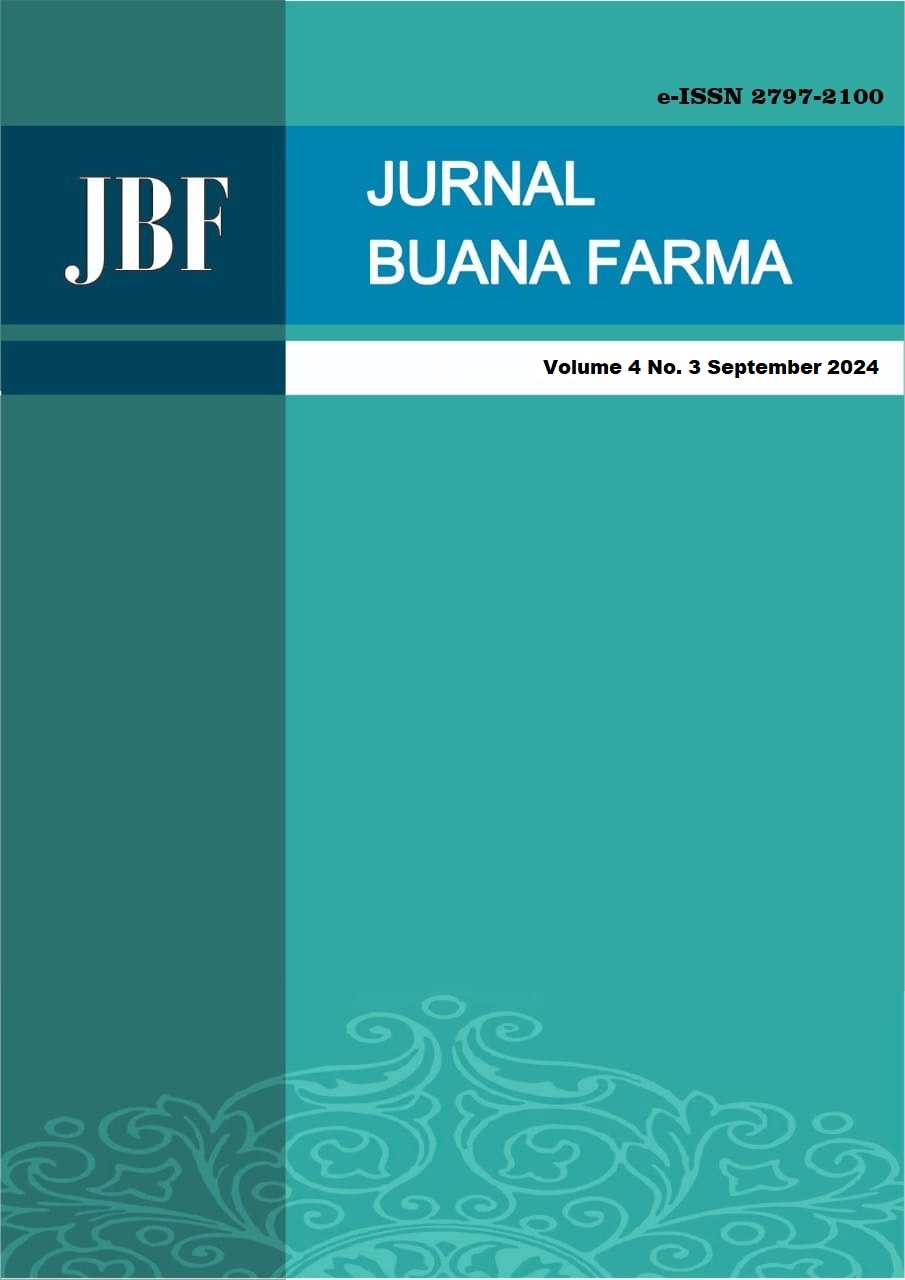ANALISIS KADAR ALKALOID DAN FLAVONOID SEDUHAN RAMBUT JAGUNG (Zea mays L. ) DENGAN METODE SPEKTROFOTOMETRI UV-VIS
Abstract
Corn silk is generally a waste of sweet corn plants after being harvested and is rarely used, however, on the other hand, corn silk is also used by the community as herbal medicine and is believed to reduce the risk of hypertension and other types of chronic diseases such as kidney infections. Corn silk is thought to contain metabolite compounds such as flavonoids, essential oils, steroids, and alkaloids. Alkaloid compounds can function as drugs and strong activators for immune cells that can destroy bacteria, viruses, fungi, and cancer cells. Flavonoid compounds are compounds that have various bioactive effects such as anti-inflammatory, antiviral, cardioprotective, anti-diabetic, anti-cancer, anti-aging, and antioxidants. it is necessary to measure the levels of alkaloids and flavonoids from corn silk infusion to determine the levels of alkaloid and flavonoid compounds in corn silk infusion. The method used in this study is the Uv-Vis spectrophotometry method. The alkaloid content was calculated using the regression formula y = 0.0895x - 0.3046, the results obtained in the corn hair infusion extract were 46.36 mg / g extract, and the flavonoid content was calculated using the regression formula y = 0.0144 x - 0.025 and the results obtained in the corn hair infusion extract were 85.42 mg / g extract. So it can be concluded that corn hair infusion contains more flavonoid compounds, namely with alkaloid compound levels of 46.36 mg / g extract and flavonoid compounds of 85.42 mg / g extract.
References
Aminah, A., Tomayahu, N., & Abidin, Z. (2017) ‘Penetapan Kadar Flavonoid Total Ekstrak Etanol Kulit Buah Alpukat (Persea americana Mill.) Dengan Metode Spektrofotometri UV-Vis’, Jurnal Fitofarmaka Indonesia, 4(2), pp. 226–230.
Arifin, B. and Ibrahim, S. (2018) ‘Struktur, Bioaktivitas Dan Antioksidan Flavonoid’, Jurnal Zarah, 6(1), pp. 21–29. doi: 10.31629/zarah.v6i1.313.
Arwangga, A. F., Raka Astiti Asih, I. A., Sudiarta, I. W (2016) ‘Analisis Kandungan Kafein Pada Kopi Di Desa Sesaot Narmada Menggunakan Spektrofotometri UV Vis’, Jurnal Kimia, 10(1), pp. 110–114.
Arwangga, A. F., Raka Astiti Asih, I. A., Sudiarta, I. W. (2016) ‘Analisis Kandungan Kafein Pada Kopi Di Desa Sesaot Narmada Menggunakan Spektrofotometri UVVis’, Jurnal Kimia, 10(1), pp. 110–114.
Bawekes, S. M., Yudistira, A. and Rumondor, E. M. (2023) ‘Qualitative Test of Chemical Content of Lime Juice ( Citrus aurantifolia Swingle ) Uji Kualitatif Kandungan Senyawa Kimia Perasan Jeruk Nipis ( Citrus aurantifolia Swingle )’, 12, pp. 373–377.
Dian Arista Setiabudi dan Tukiran (2017) ‘Uji Skrining Fitokimia Ekstrak Metanol Kulit Batang Tumbuhan Klampok Watu (Syzygium litorale)’, UNESA Journal of Chemistry, Vol. 6, No.
Elfiyani, R., Radjab, N.S., dan Harfiyyah, L. . (2014) ‘Perbandingan Penggunaan Asam Sitrat dan Tartrat Terhadap Sifat Fisik Granul Effervescent Ekstrak Kering Kulit Buah Manggis (Garcinia mangostana L.)’, Jurnal Media Farmasi, 11(7–17).
Ergina, Siti Nurhayati Nurhayanti, dan I. D. P. (2014) .‘, Uji Kualitatif Senyawa Metabolit Sekunder pada Daun Palado (Agave angustifolin) yang Diekstraksi dengan Pelarut Air dan Etanol’, J. Akad Kim V, Vol 3 No 3.
Garnida Y, Suliasih N, I. P. (2018) ‘Pengaruh suhu pengeringan dan jenis jagung terhadap karakteristik teh herbal rambut jagung (Corn silk Tea)’, Pasundan Food Technology Journal, 5(1), pp. 63–71.
Hartini S.Y dan Wulandari E.T (2016) Buku Panduan Praktikum Farmakologi Fitokimia. Fakultas Farmasi Universitas Sanata Dharma.
Haryati, N.A., C. S. E. (2015) ‘Uji Toksisitas dan Aktivitas Antibakteri Ekstrak Daun Merah (Syzygium mytifolium Walp) terhadap Bakteri Staphylococus aureus dan Escherichia coli’, Kimia Mulawarman, 13(1): 35-.
Jannah A, Rachmawaty DU, M. A. (2017) ‘Uji aktivitas antibakteri ekstrak etanol, etil asetat dan petroleum eter rambut jagung manis (Zea Mays Saccarata Strurt) terhadap bakteri Staphylococcus aureus dan Escherichia coli’, Alchemy, 5, pp. 132–137.
Koloay K (2015) ‘Uji efektivitas ekstrak etanol rambut jagung (Zea Mays L.) terhadap penurunan kadar gula darah tikus putih jantan galur wistar (Rattus Norvegicus L.) yang diinduksi aloksan’, Pharmacon., pp. 434–440.
Lim, Y. Y., Murtijaya, J. (2006) ‘Antioxidant Properties of Phyllanthus amarus extract as effected by different drying methods’, Elsevier LWT 40, pp. 1664–1669.
Maisarah, M., Chatri, M. and Advinda, L. (2023) ‘Characteristics and Functions of Alkaloid Compounds as Antifungals in Plants Karakteristik dan Fungsi Senyawa Alkaloid sebagai Antifungi pada Tumbuhan’, Serambi Biologi, 8(2), pp. 231–236.
Noviyanty Y, Hepiyansori, A. Y. (2020) ‘Identifikasi dan Penetapan Kadar Senyawa Tanin pada Ekstrak Daun Biduri (Calotropis gigantea) Metode Spekktrofotometri UV-Vis’, Jurnal Ilmu Manuntung, 6(1), pp. 57–64.
Olivia, F. , Alam, S., & Hadibroto, I. (2004) Seluk Beluk Food Suplemen. Jakarta: Gramedia.
P. Agustine, R. putri Damayanti, N. A. (2021) ‘KARAKTERISTIK EKSTRAK KAFEIN PADA BEBERAPA VARIETAS KOPI DI INDONESIA: REVIEW’, Jurnal Arti, 6, pp. 78–89.
Qinghu, W., Jinmei, J., Nayintai, D., Narenchaoketu, H., Jingjing, H., Baiyinmuqier, B. (2016) ‘Anti-Inflammatory Effects, Nuclear Magnetic Resonance Identification And High-Performance Liquid Chromatography Isolation Of The Total flavonoids From Artemisia Frigida’, Journal of Food and Drug Analysis, 24, pp. 385–391.
Rhaihana Bachtiar (2023) ‘Penetapan Kada Flafonoid Total Buah Dengen (Dillenia serrata) Mengunakan Metode Spektrometri Uv-Vis’, Makassar Natural Product Journal, 1(2), pp. 2023–86. Available at: https://journal.farmasi.umi.ac.id/index.php/mnpj.
Saepudin, Syumillah, and Y. S. (2022) ‘Alpha-glucosidase inhibitor activities and phytochemicals screening of the Peperomia genus cultivated in Indonesia’, International Journal Of Applied Pharmaceutics, 14.
Siswarni MZ, Yusrina Ika Putri and Rizka Rinda P (2017) ‘EKSTRAKSI KUERSETIN DARI KULIT TERONG BELANDA (Solanum betaceum Cav.) MENGGUNAKAN PELARUT ETANOL DENGAN METODE MASERASI DAN SOKLETASI’, Jurnal Teknik Kimia USU, 6(1), pp. 36–42. doi: 10.32734/jtk.v6i1.1563.
Utami, Y. P., Umar, A. H., Syahruni, R., & Kadullah, I. (2017) ‘Standardisasi Simplisia dan Ekstrak Etanol aun Leilem (Clerodendrum minahassae Teisjm. & Binn.)’, Journal of Pharmaceutical and Medicinal Sciences, 2(1).
Wahyuni Septia., Marpaung Pandapotan, M. (2020) ‘Penentuan Kadar Alkaloid Total Ekstrak Akar Kuning (Fibraurea Chloroleuca Miers)’, Jurnal Ilmu Kimia, 3(2).













